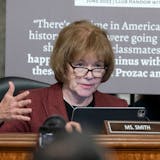Six years ago as a sixth-grader, Elijah Stende began to map out his future, and it involved attending college and becoming a nurse someday.
Fortunately, he was in the right school to help put him on that path.
Open World Learning Community in St. Paul makes it a practice to remove barriers to student participation in rigorous dual credit classes. Anyone can take its AP (Advanced Placement) courses, and they are encouraged to do so, with a potential payoff being the awarding of college credits following a successful final exam.
The grades 6-12 school was one of three in Minnesota to be recognized last year for not only having a high percentage of exam takers, but also for attracting students of color and those from families with lower incomes in numbers that mirror the school’s overall demographics. Now, the goal of increasing access for underrepresented students is drawing bipartisan support at the State Capitol.
State Rep. Matt Norris, DFL-Blaine, is sponsoring a bill promoted by the education advocacy group EdAllies that would automatically enroll into advanced courses those students who demonstrate proficiency in a subject area via a strong standardized test score or an earlier course grade, for example.
Students could decline to be part of what is now being pitched as a pilot project.
“I think the goal of this bill is fantastic,” state Rep. Ben Bakeberg, R-Jordan, said during a recent House committee hearing. “Giving as many students access, and pushing kids, is a phenomenal goal.”
In his presentation, Norris cited data reported recently by the state Department of Education showing that participation in AP courses declined by 20% for students overall between 2019-20 and 2021-22, and 41% for low-income students. For students of color, participation dropped by 15%.


